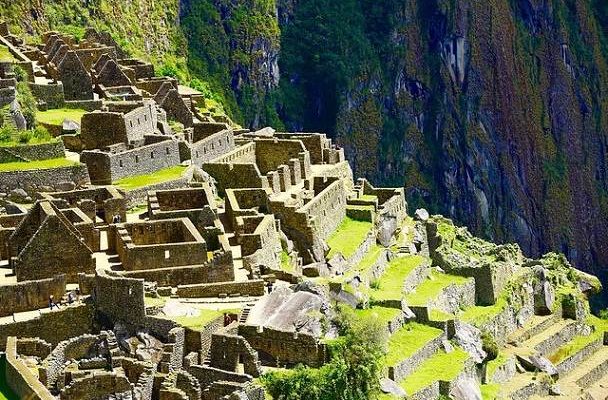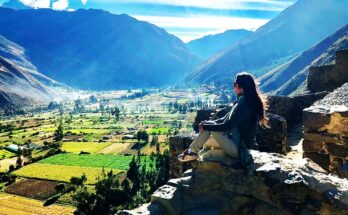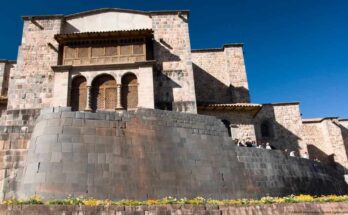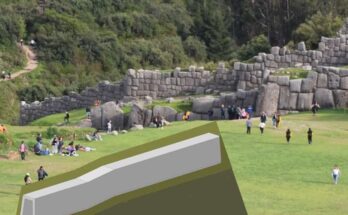The Inca Trail is the most mythical and mystical trek, four days of walking, giving you a unique experience as you reach the Puerta del Sol (Intipunku) or see the first panoramic view of Machu Picchu.
Some say that the trek was much better before and that it has lost its charm. While there are hundreds of beautiful treks to walk in Peru, this is the only one that goes directly to Machu Picchu. Other alternative and popular treks are the Salkantay and Lares; the first trek goes to Hidroelectrica and then to the town of Machu Picchu, below the citadel and the second goes to Ollantaytambo, where the trains depart.
But if you want a unique experience at Machu Picchu, you will need to hike and suffer a little.
First: Make a reservation. To conserve the path, only 500 people a day can travel the trail, including guides and carriers. Make your reservation several months in advance. For example: right now, there are no spaces in October.
Check the availability on this page. This page also provides access to the list of agencies, guides and porters. In the availability section, you can view the agencies that enter frequently and the number of visitors traveling with them. It is forbidden to enter on your own. You have to go through one of the agencies that have space available.
Next: Prepare yourself. Arrive to Cusco or the Sacred Valley a few days before your excursion, allowing your body to become acclimated. There are short walks near each town to help get into shape. You have to carry your own personal items: a good sleeping bag, light weight objects and don’t forget your rain coat. Besides walking everywhere, use a good pair of shoes; if they are new, give time for your feet to get used to them. I recommend spending a few nights in Urubamba, in the cozy Villa Urubamba or in Ollantaytambo, in the Casa de Campo Mama Simone. These two villages are the closest to the starting point.
During: breathe. The trek is difficult. You will be walking for various hours, between 5-10 hours, depending on the day and the physique of each person. Many ups and downs, with steps that seem endless. But always keep in mind, that nothing is impossible. Everyone can try and do it. It´ll be easier if you are physically fit or if you get into shape just before the excursion. The agency will bring good food and snacks and their tents are in good condition. Try not to carry unnecessary baggage.
The classic. 4 days/ 3 nights. Start at Km 82, next to the railway.
Day 1: 13 kms to the archaeological site of Patallacta. 5 hours. Huayllabamba camp.
Day 2: 11 kms to Wuarmihuañusca, 4,200 meters high, with spectacular views. Then, downhill into the Pacaymayo valley. 7 hours. Night in Pacaymayo.
Day 3: 16 kms, the day that requires the most effort. Go through the Runquracay, Sayacmarca and Phuyupatamarca archaeological sites. From the third day on, the paths are fully paved. 10 hours. Night in Wiñayhuayna, bordering the jungle.
Day 4: 5 kms to IntiPunku and Machu Picchu. Depart early in the morning to get to La Puerta del Sol Inca at dawn and live a moment from a dream. Return the same day by bus or train. You can stay an extra night and enjoy more of the Citadel, which will cost you a bit extra.
Light. 2 days/ 1 night. Few know, but there is a lighter version of the Inca Trail. It consists of a one day walk that starts at Km 104 and offers limited spaces to preserve the path. Begin your excursion from the Chachabamba ruins and go up to the Choquesuysuy site and head towards Wiñaywayna, with extraordinary waterfalls. Return to Intipunku before 4 pm to end your trek for the day. After the afternoon comes to an end, spend a night in the town of Machu Picchu. Be sure to make reservations in advance. To treat yourself, the Sumaq hotel or MAPI hotel. For an average budget, Panorama B & B or the Treehouse Rupa Wasi. For backpackers, the Supertramp or the Pirwa. Many agencies do not include night accommodations, but are expected to return with you to Machu Picchu (by bus) the next day, to explore all day.
The best time to go. Every year, the Inca Trail is closed for maintenance in February. It is ideal to visit from May to September, when there is more of a chance to see blue skies. In March and April there can be heavy rainfall. From October to December rain is scarce, but the weather is a bit grayer. One more tip: wait. At Machu Picchu, the day often starts out cloudy, but the weather changes. Always wait. If you don´t get to see the sun, enjoy the dance of the clouds over the citadel and Huayna Picchu, you will still feel all its magic and mystery.
Good prices. Prices are varied according to the agency, the comfort of the tents and food. Prices also depend on how many people there are per group. Prices start from US $590 for the 4 day excursion. Hiring a porter to carry up to 15kg, costs an extra US $160. You can optionally add one more day with an extra entrance to Machu Picchu, a more comfortable train back and an extra night in the town of Machu Picchu. The 2 day excursion costs about the same: US $585, including a visit to Machu Picchu, one day of trekking and an extra ticket, in addition to the night in the town of Machu Picchu. If you want to cancel the reservation, keep in mind that some agencies reimburse up to 70%. The amount paid to the Ministry of Culture, to reserve your space, is nonrefundable.
The solution, if there are no spaces. Spaces to go on the Inca Trail are hard to get. In any case, when you go to Machu Picchu, you can walk to Intipunku on your own. It is a light uphill trek, less than 1 hour from the citadel. You will see the steps that the brave once climbed and a beautiful view and the dream picture.
Let´s hike! Happy travels.



